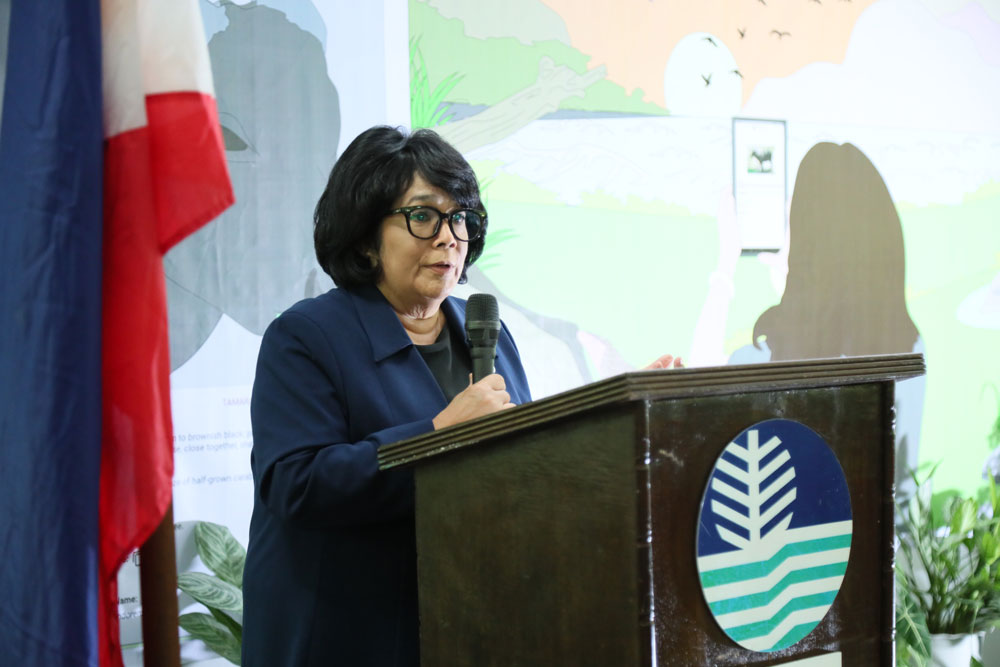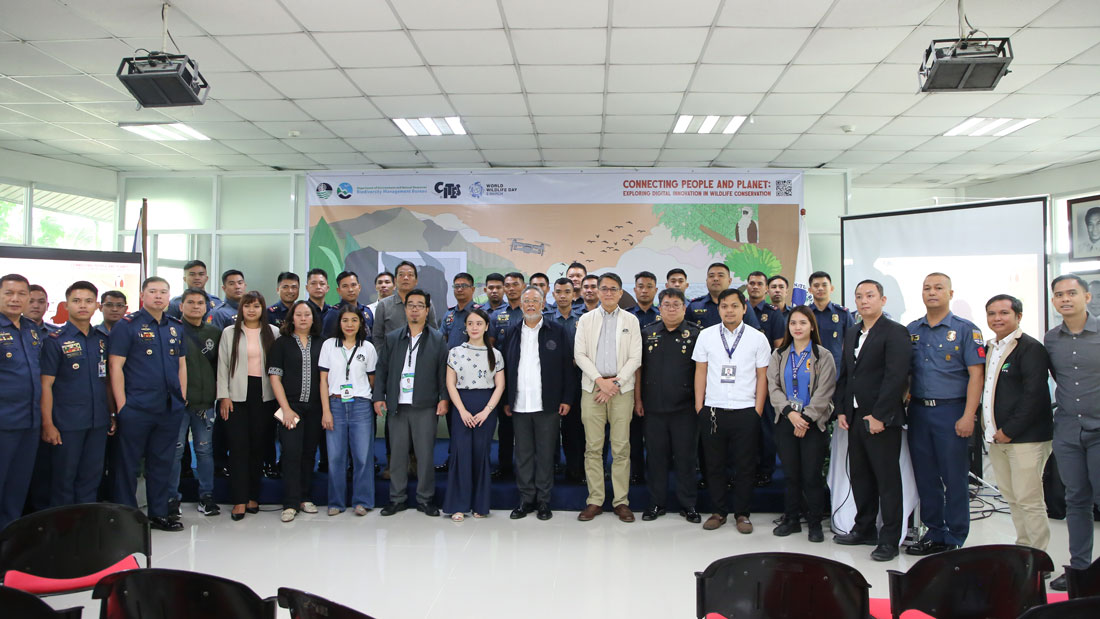 I know that there is an ongoing hearing on ICM and we actually have our Assistant Secretary Marcial Amaro actually there so we greet both of them. Of course, our principle sponsor in the Senate, the Chairperson of the Philippine Senate Committee on Environment and Natural Resources and Climate Change, our strong supporter Senator Cynthia Villar, and of course our ASec Amaro is there, our Assistant Secretary for International Affairs and Concurrent OIC Director of Biodiversity Management Bureau (BMB). I know that we also have colleagues from the DA-BFAR. Executive Director of the Palawan Council for Sustainable Development (PCSD), of course, our colleague Atty TJ Matta. And then of course our friends and resource speakers, USec Adobo who supervises the BMB, our colleagues from the USAID SIBOL, BD Corridor Project and PENAGMANNAK INC., representatives from various wildlife law enforcement agencies, our friends from the PNP wildlife permit holders; representatives from the DENR Regional Offices, ladies and gentlemen, good morning.
I know that there is an ongoing hearing on ICM and we actually have our Assistant Secretary Marcial Amaro actually there so we greet both of them. Of course, our principle sponsor in the Senate, the Chairperson of the Philippine Senate Committee on Environment and Natural Resources and Climate Change, our strong supporter Senator Cynthia Villar, and of course our ASec Amaro is there, our Assistant Secretary for International Affairs and Concurrent OIC Director of Biodiversity Management Bureau (BMB). I know that we also have colleagues from the DA-BFAR. Executive Director of the Palawan Council for Sustainable Development (PCSD), of course, our colleague Atty TJ Matta. And then of course our friends and resource speakers, USec Adobo who supervises the BMB, our colleagues from the USAID SIBOL, BD Corridor Project and PENAGMANNAK INC., representatives from various wildlife law enforcement agencies, our friends from the PNP wildlife permit holders; representatives from the DENR Regional Offices, ladies and gentlemen, good morning.
Today, we are commemorating the 2024 World Wildlife Day. It is indeed a great pleasure to be in solidarity with everyone, and to the international community in celebrating this remarkable event that highlights the need to conserve our wildlife species, a component of biodiversity which is our life support system as a country and as a world.
With this year’s theme, “Connecting People and Planet: Exploring Digital Innovation in Wildlife Conservation”, the WWD 2024 aims to shed light on the latest and newest applications of digital technologies to promote wildlife conservation. The celebration will also delve into digital innovations and will tackle how digital technologies and services can drive harmonious relationships between humans and wildlife, and the ecosystems that support us at the present time and for future generations to come.
Now that digital technology is more accessible to us, connecting and communicating, as well as generating and sharing knowledge are as efficient as they can be now more than ever. With digital technologies, regulators and law enforcers will certainly be equipped in implementing laws, rules and regulations. Hence, we should maximize the advantages these digital technologies have to offer in various applications in the implementation of our plans and programs on environmental protection and conservation.
The application of digital innovations in combatting illegal wildlife trade is one area needing constant exploration and action. In the past years, we have invested heavily in developing and implementing regulatory mechanisms to curb illegal wildlife trade while promoting sustainable use of our natural resources. However, wildlife crime has become more engineered, more sophisticated, and more well-planned by individual offenders and syndicates alike with the aid of modern technologies, as well. They have established linkages and networks, making illegal wildlife trade transactions more efficient, fast-moving, and easier to circumvent the established procedures for illegal and sustainable wildlife trade.
Recognizing these challenges, digital technologies are now being incorporated into the strategies for wildlife protection and conservation. One of which is the use of electronic permitting systems called “eCITES PH” that can prevent fraud in wildlife trade. It promotes paperless transactions to ensure legal, sustainable and traceable trade of wildlife. Likewise, we have developed a mobile application tool for monitoring and reporting wildlife crimes which is known as the WildALERT or Wildlife Agency and Citizen Law Enforcement Reporting Tool. Our Colleagues from BFAR and PCSD, I understand also have their own relevant initiatives which will be shared by their respective representatives.
As we continue to innovate digitally to keep up with the times, the DENR counts on the continuing collaboration and support of our partners in wildlife conservation and law enforcement. I am glad that some of them are represented here today and I wish to thank them once again: the USAID through their project on Interventions for Biodiversity, Ocean, and Landscapes Project or the SIBOL Project, the UNDP through their Biodiversity Corridor Project, and the PENAGMANNAK Inc., who are exemplary in terms of people’s organizations in order to combat illegal wildlife trade as well as conservation to impart their initiatives related to our theme. The achievements in wildlife protection and the implementation of the Wildlife Act or RA 9147 is also a result of collaboration with government enforcement agencies. Thus, we are celebrating World Wildlife Day with the 10th Wildlife Law Enforcement Awarding Ceremony to recognize the efforts by more than a hundred officials in enforcing the provisions of the Wildlife Act (RA 9147), primarily from the National Bureau of Investigation (NBI), the Bureau of Customs (BOC), PNP – Maritime Group, the PNP – Criminal Investigation and Detection Group (PNP-CIDG), and PNP Police Regional Offices.
Bounded together by common interest to keep our environment livable and sustainable, our partnerships in wildlife conservation and the protection of the environment in general should be fueled with more zeal and passion. Moreso, as we face the challenges of the triple planetary crisis: climate change, pollution and biodiversity loss. In 2022, 196 nations through the Convention on Biological Diversity committed to a more ambitious target to keep 30% of the earth’s land and marine habitat in their natural state in order to prevent the extinction of species. We shall remain steadfast in our collective efforts and invite you all to continue to innovate, not just strategies but also in terms of operations and the use of modern technologies to contribute to this global movement and to save our own living environment.
And here I wish to thank, before I close, Senator Cynthia Villar. For her funding, that she sponsored and successfully granted in our 2024 budget – to enable drone-based observation in many of our protected areas. This is the first time that we have been able to receive such level of funding and this information will help us in terms of our own monitoring of trafficking as well. I also wish to share that we have now also funding for the conservation of five species including Dugong, the Palawan Cuckatoo, the Philippine Eagle, Marine Turtles, and the Tamaraw, and we hope to grow that funding each year for other species as well. We also have new six Marine Scientific Stations that have been funded in this year’s budget. They were also be collecting data and digitally transmitting this is in order for us to monitor what is going on in the six marine biogeographic areas of the country.
And lastly, I wish to share that last week we launched a Philippine Space Agency – DENR collaboration. That includes the application of space technology, AI, and machine learning in mapping our mangrove areas in the country. This combination of services and technologies and approaches will also help us in terms of our conservation and protection. With inspiration from the World Wildlife Day celebration, may each one of us be an ambassador for the protection and conservation of our wildlife. Let us be the voices that cannot be heard in order to create awareness, and to protect, and take active part in conservation and prevention of illegal wildlife trade. Digital technologies have their use and their value lies on the values of those that are applying the digital technologies for their specific targets and goals.
So, thank you very much, and have a great World Wildlife Day.####













